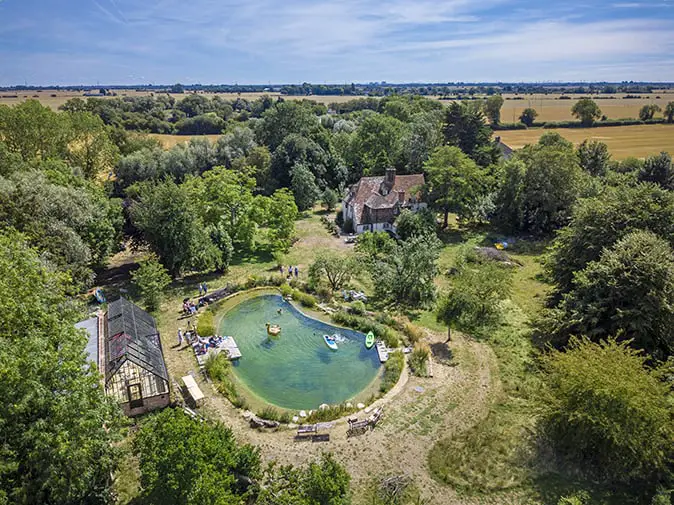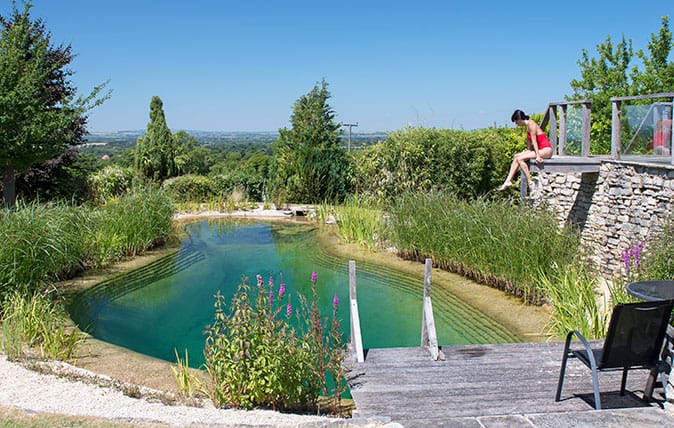Swimming is one of the summer’s perfect pleasures. A pleasure you may do right inside your backyard with an inviting splash of your swimming pool. Practicing your swimming skills or an afternoon relaxation, a swimming pool that is built with nature that blends into the natural landscape is the perfect place for that. A kind of experience you can feel in a natural swimming pool.
The rise of the natural swimming pool is at its peak. As most of the homeowners have learned how to build pools that didn’t use a mass of manufactured materials and chemical additives. Imagine a chemical-free and environment-friendly in one kind of pool. A natural swimming pool uses clay and gravel stone and aquatic plants in water filtration eliminating the use of harmful chemicals directly to the pool water. Natural pools are fairly low-tech and once established it requires minimal maintenance.
A natural swimming pool is a bit different than the regular swimming pool you usually used. Natural swimming pools are a self-cleaning pool constructed with a wetland ecosystem. This kind of pool is not built to look the same, it is often designed to imitate pools, ponds and other bodies of water in the wild using realistic rocks and boulders. Natural pools are filtered organically using gravel filter or aquatic plants resembles the process as natural ponds are cleaned. Basically, to reduce the nutrients in the water through microorganisms of the plant to prevent algae formation and keep the water clear.
Natural pools are very adaptable in design. You can make it look like a traditional pool or an image of a brown natural pond by installing the right materials that will make the pool complete its natural appearance. You can create a mud-like bottom using filled concrete with an underground or hidden gravel filter. In terms of design and aesthetic, you can turn this pool into a simple natural pool or a realistic forest pond. (Learn more about a natural swimming pool, you can check our article How Does a Natural Swimming Pool Work?)
A natural swimming pool can be built in the flexible design of your own preference. A natural pool can be expensive if you hire a professional contractor helping you build your dream natural pool. But with the help of some tricks, you may do your own natural swimming pool in the most affordable way. Make your dream natural swimming pool into a reality by making your own DIY pool. Prepare the design on your mind, materials needed and your DIY skills as we give you 10 important tips in building a Do It Yourself natural swimming pool.

1. Keep the Design Simple
A minimum design makes your natural swimming pool more attainable. The simpler the structure, the likely it is to achieve. First, get the basics requirements in building the natural pool; the size, shape, the materials needed, before thinking the extra features of the pool. Choose a simple shape that is suitable for the area you would construct the pool. Create a step by step plan for every part of the pool building and make sure that you are stick with your timeline or schedule. Lastly, keep extra cash available for emergency purposes.
2. Choose a Flat Bottom Pool Design
As we mentioned on our first tip, choose the most attainable design and especially it reduces the construction cost. The pool ground is the first part involved. Having a single and flat bottom pool is easier to perfect in lesser time. A flat base natural pool means a simple dig and much easier one level foundation for the pool wall. After the construction, a flat bottom pool takes less maintenance and easier to clean than other complex designs.
3. Get the Right Pool Area Zoning
Before the construction, make sure to locate and properly measure the size of your natural pool. Ensure extra space that you possibly need for other purposes. Plot the exact measure and prevent overestimating the amount of space you have to work on. Try to consider a traditional shape for easy plotting and to achieve the perfect fit of the backyard’s natural pool.
A natural swimming pool requires a double size of your preferred swimming space. The other half is reserved for pool filtration and plant vegetation. It is called the regeneration area where the ecosystem resides or the aquatic plants and landscape will be build that serves as natural filters of the pool. It inhibits the use of pool chemicals needed for water filtration and cleaning.
4. Consider a Pool Not Too Deep
A natural swimming pool can be as shallow or deep as you like. In DIY, it is advisable to stick to 1.8 meters or less as it needed more reinforcements giving extra cost. A shallower pool gave the advantage of the cleaning and maintaining easier when the pool is operational. Remember to check the retaining wall when in doubt to ensure stability.
5. Prevent Concrete or Prefabricated Pool Walls
Creating depth in the middle of the pool while bringing the base up to a shallower depth at the sides by using stones or sandbags to form walls. But be careful about the installation, if it is sloppy the flat liner and sandbags can give you a pool finish.
6. Avoid Too Many Fittings
Same as other swimming pools, it requires inlet and outlet pipes. Make sure it doesn’t ruin the look of the entire pool by blending the fittings in. If you want automatic skimming to consider a balance tank to avoid complicated fittings. For small natural pools, you can skim using a leaf net. Avoid too many fittings that may affect the waterproofing so be careful in choosing the right fittings cause it may help or cause the problem in terms of plumbing and overall aesthetic. Be creative and quirky this time without releasing too much money. Use your wide imagination in hiding those fittings.
7. Get Your Right Drainage System
The drainage system, make it or break your whole construction project. Choosing the right position of your pool helps a lot in plotting the right drainage system. Position your pool that isn’t the lowest point of your backyard you would able to set up the drainage in the right angle to prevent flooding of the entire backyard. Also, remember that the drainage pipes are not that visible that can ruin your beautifully landscaped natural swimming pool. Digging a natural well can also be an alternative in preventing your backyard from turning into a swamp without the proper drainage.
8. Using a Black Lining Can Cut the Cost of Construction
Too much installed an electric heater in your natural pool can be an obstruction to your pool’s environmental vibes. Reduce the need for electric heater or even remove it entirely by installing black pool lining. Color black absorbs heat than lighter colors so the lesser the pool heater also helps the natural look of the swimming pool. Plus, even cheaper maintenance for the pool.
9. Always Prepare your Materials In Advance
Preparing the needed materials before the start of the pool construction can give you a smooth workflow. No need for waiting, keep the construction rolling, with that you can get the right track of your construction timeline. Listing the commonly used materials and tools that you will need in constructing your natural pool:
- Cement
- Sand
- Gravel
- Clay
- Boards for formworks and bars
- Liquid gas
- A mixer
- A hammer
- Shovel
- Hacksaws
- Plier
- Plumb
- A level
10. Always Be Realistic
Building your DIY natural pool will be a success if you are determined to make it real. Prepare the basics before adding extra features that you may consider the least. Determine the exact budget and don’t exceed your target amount. Always be prepared with unprecedented constraints that may affect the construction like weather conditions and the like. Finally, having a simple but realistic natural swimming pool is better than nothing at all.
Conclusion
Are you ready for your DIY natural pool project? Prepare everything you need and keep these helpful tips to start your natural pool construction. Turn your picture-perfect plan into an aesthetically beautiful water oasis. Improve your backyard with an eco-vibe natural swimming pool that adds quality in your precious home.


